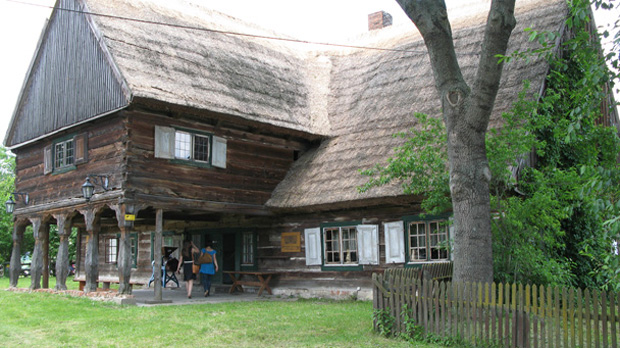Between June 13 and 19 this summer, I was invited to participate in two Mennonite history-related events in the Chelmno region of Poland. I was asked by the Parks Service of Poland and the Friends of the Lower Vistula Association to speak at a conference detailing the cultural history of the Vistula River Valley. I was also asked to attend and present at the Chrystkowo open-air museum “Weekend with Mennonites” festival.
Mennonites began to settle in what is now Poland (part of which was known as Prussia) in the mid-1500s and lived there until 1945. Much of what is considered traditional about Russian-Mennonites has its origins in that area – including the housebarn architecture at the Mennonite Heritage Village.
Mennonites are currently very popular as a topic in Poland, due in large part to the popularity of a certain Russian singer who claims Mennonite heritage. However, they are also acknowledged to have been a peaceful people who helped reclaim flood-prone land for agriculture that the Polish people still use. I was somewhat embarrassed when I heard it put like this: “A long time ago there were these angels who created this paradise.” What is generally ignored is the complicity with which many Mennonites lived with and even joined the Nazi party during the first half of the 20th Century. All Mennonites left the country at the end of World War II, fleeing westward with the Germans, and eventually settled in Germany or Canada. And it seems from my discussions there that Poles are still quite suspicious of German activities and motives.
Be that as it may, a number of Polish heritage groups have recently tried to re-educate the Polish population about Mennonite habitation in their country, and have had quite a bit of success accessing European Union funding for creating heritage sites. My trip to Poland was directly related to these efforts.
My host was Wojceich Marchlewski, who has researched and published about Mennonite settlements in Poland. On our travels, Marchlewski took to me to numerous Mennonite architectural sites.
At the conference in Chelmno, I gave a presentation about Mennonite landscapes in the Vistula River Valley, and the continuity in work habits, landscape and architecture that extended into Russia and Canada. A version of the presentation has been published in Polish.
That evening, scholars and international guests were invited to a watermill heritage site at Gruczno. The evening included a “Slow Food” night of multiple courses of local recipes, a forerunner of the Chelmno annual Slow Food event which draws over 15,000 people. Exhibits included the water mill, steam engine demonstrations, fascine (wattle) fences and bee hives.
Saturday, June 15 was the first day of “Das Wochenende mit Mennoniten” at Chrystkowo, a small village near Chelmno. This open air museum features one large Mennonite style house built in 1770. Here I gave a Power Point presentation for the general public as part of a series throughout the afternoon about Mennonites around the world. I presented about Mennonites in Canada (historic and modern); others presented on Mennonites in Mexico, Poland and The Netherlands.
Demonstrations and exhibits at the event included cheese making, reconstructed 17th century wooden wheelbarrows and spades, basket weaving, doily making, steam tractors, ice-cream making and historic fishing in a pond. The highlight was a cooking contest between 3 groups of college students, who were tasked with cooking traditional Mennonite food by their professor. The judges included a restaurant critic from Warsaw, the Dutch Mennonites, and me (a last minute decision). The students cooked throughout the day in the kitchen of the housebarn. I was partial to the Sommaborscht (which won the contest).
I attended a meeting of about 10 people (Friends of the Lower Vistula Association, academics, Parks Service representatives) regarding the future of Chrystkowo and the direction of the heritage site. The discussion was wide ranging, but I was able to make some suggestions, such as building for local community use (broader use as a cultural centre), presenting a unique theme, and developing a Mission Statement and initial policies and procedures.
I then received a wonderful, in-depth tour of the 1770 house from Mr. Marchlewski. What struck me was the similarity in design of the rooms of the house with our own housebarns at the museum, although the Polish house was much larger.




